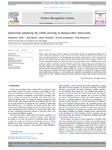Supervised autonomy for online learning in human-robot interaction
| dc.contributor.author | Senft, E | |
| dc.contributor.author | Baxter, P | |
| dc.contributor.author | Kennedy, J | |
| dc.contributor.author | Lemaignan, S | |
| dc.contributor.author | Belpaeme, T | |
| dc.date.accessioned | 2017-04-26T15:12:26Z | |
| dc.date.available | 2017-04-26T15:12:26Z | |
| dc.date.issued | 2017-03-18 | |
| dc.identifier.issn | 0167-8655 | |
| dc.identifier.issn | 1872-7344 | |
| dc.identifier.uri | http://hdl.handle.net/10026.1/9123 | |
| dc.description.abstract |
When a robot is learning it needs to explore its environment and how its environment responds on its actions. When the environment is large and there are a large number of possible actions the robot can take, this exploration phase can take prohibitively long. However, exploration can often be optimised by letting a human expert guide the robot during its learning. Interactive machine learning, in which a human user interactively guides the robot as it learns, has been shown to be an effective way to teach a robot. It requires an intuitive control mechanism to allow the human expert to provide feedback on the robot’s progress. This paper presents a novel method which combines Reinforcement Learning and Supervised Progressively Autonomous Robot Competencies (SPARC). By allowing the user to fully control the robot and by treating rewards as implicit, SPARC aims to learn an action policy while maintaining human supervisory oversight of the robot’s behaviour. This method is evaluated and compared to Interactive Reinforcement Learning in a robot teaching task. Qualitative and quantitative results indicate that SPARC allows for safer and faster learning by the robot, whilst not placing a high workload on the human teacher. | |
| dc.format.extent | 77-86 | |
| dc.language | en | |
| dc.language.iso | en | |
| dc.publisher | Elsevier BV | |
| dc.subject | Human-Robot interaction | |
| dc.subject | Reinforcement learning | |
| dc.subject | Interactive machine learning | |
| dc.subject | Robotics | |
| dc.subject | Progressive Autonomy | |
| dc.subject | Supervised autonomy | |
| dc.title | Supervised autonomy for online learning in human-robot interaction | |
| dc.type | journal-article | |
| dc.type | Article | |
| dc.type | Proceedings Paper | |
| plymouth.author-url | https://www.webofscience.com/api/gateway?GWVersion=2&SrcApp=PARTNER_APP&SrcAuth=LinksAMR&KeyUT=WOS:000413463700010&DestLinkType=FullRecord&DestApp=ALL_WOS&UsrCustomerID=11bb513d99f797142bcfeffcc58ea008 | |
| plymouth.volume | 99 | |
| plymouth.publication-status | Published | |
| plymouth.journal | Pattern Recognition Letters | |
| dc.identifier.doi | 10.1016/j.patrec.2017.03.015 | |
| plymouth.organisational-group | /Plymouth | |
| plymouth.organisational-group | /Plymouth/Faculty of Science and Engineering | |
| plymouth.organisational-group | /Plymouth/REF 2021 Researchers by UoA | |
| plymouth.organisational-group | /Plymouth/REF 2021 Researchers by UoA/UoA11 Computer Science and Informatics | |
| plymouth.organisational-group | /Plymouth/Research Groups | |
| plymouth.organisational-group | /Plymouth/Research Groups/Marine Institute | |
| plymouth.organisational-group | /Plymouth/Users by role | |
| dcterms.dateAccepted | 2017-03-17 | |
| dc.rights.embargodate | 2018-3-18 | |
| dc.identifier.eissn | 1872-7344 | |
| dc.rights.embargoperiod | No embargo | |
| rioxxterms.versionofrecord | 10.1016/j.patrec.2017.03.015 | |
| rioxxterms.licenseref.uri | http://www.rioxx.net/licenses/all-rights-reserved | |
| rioxxterms.licenseref.startdate | 2017-03-18 | |
| rioxxterms.type | Journal Article/Review |


